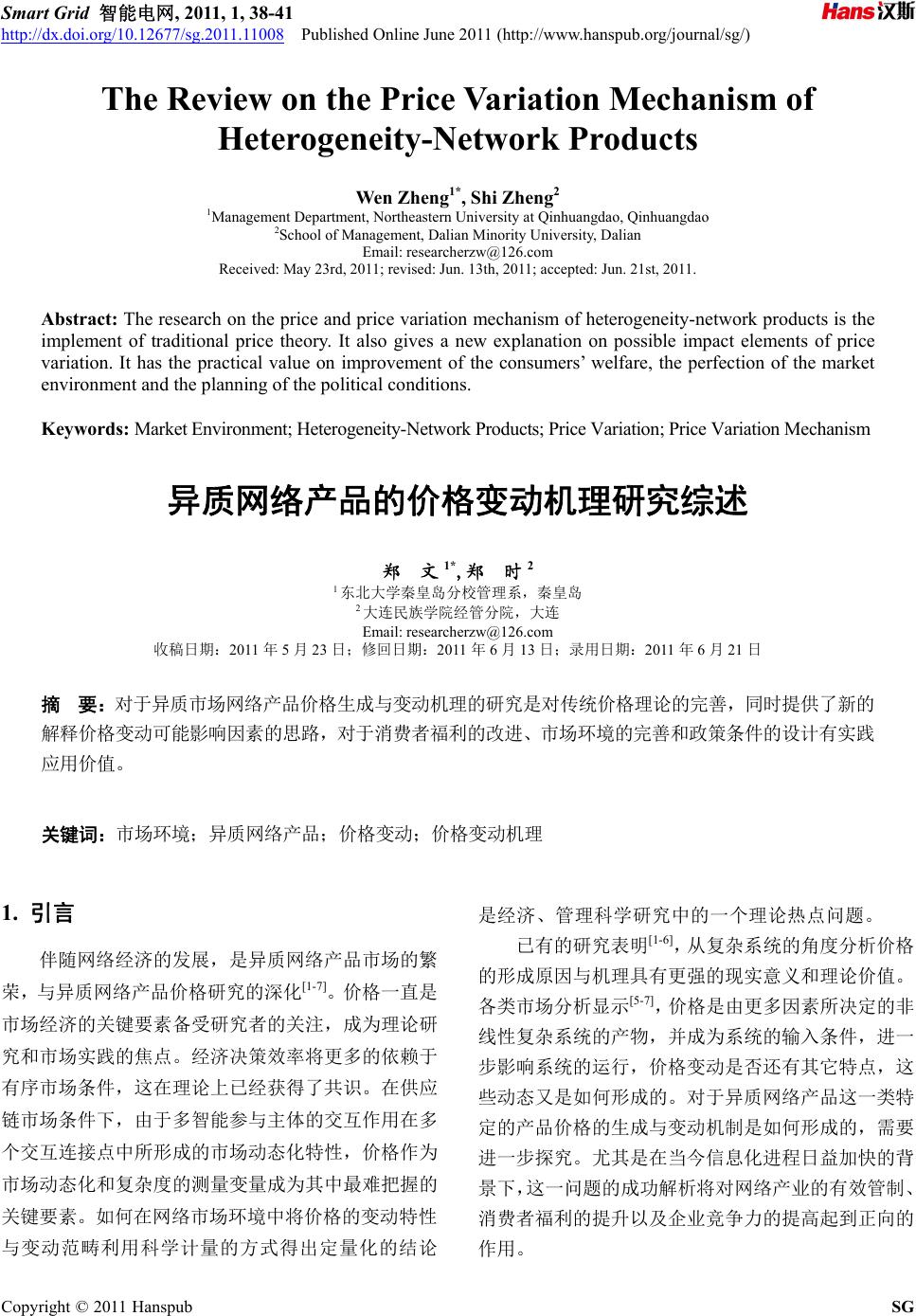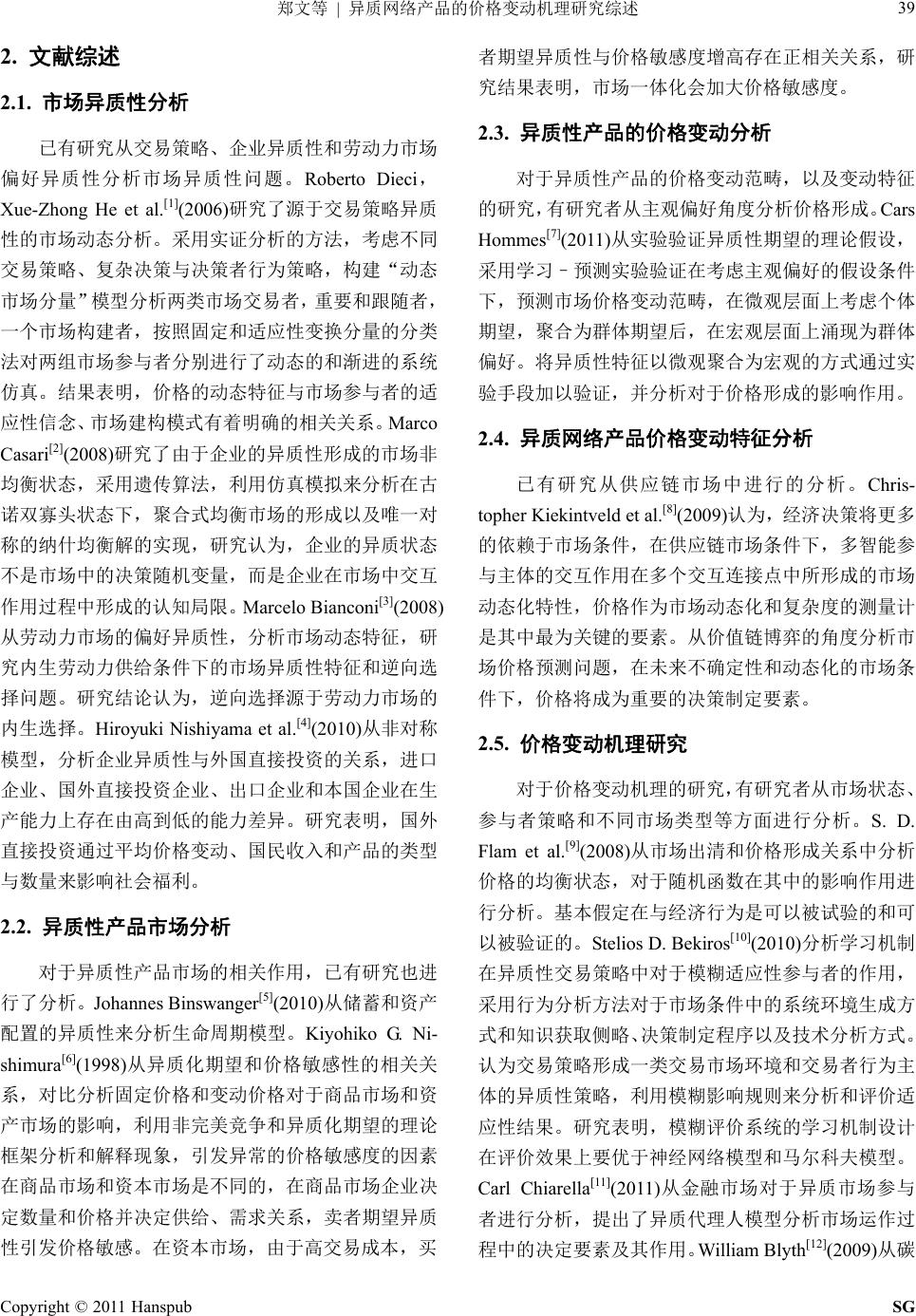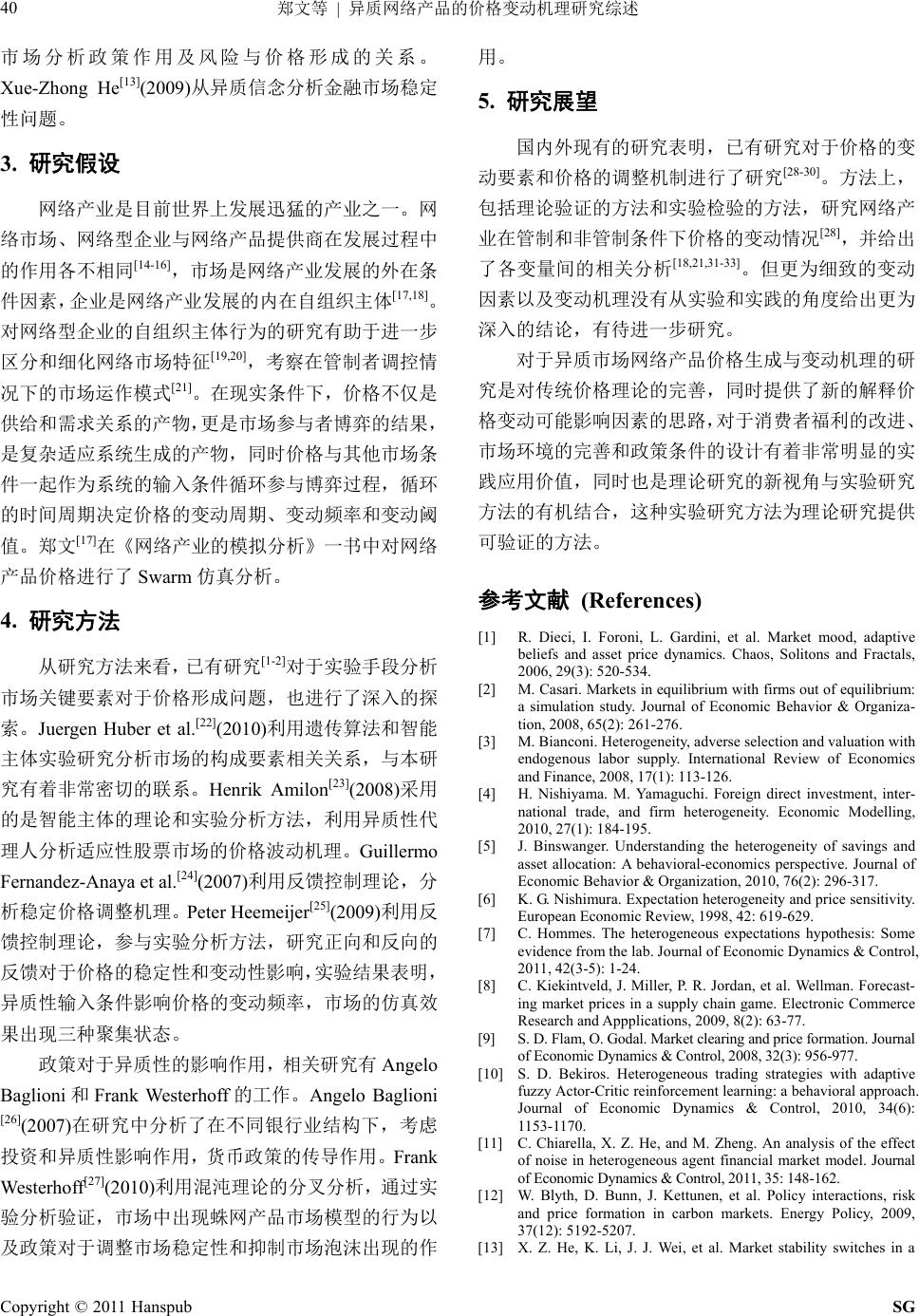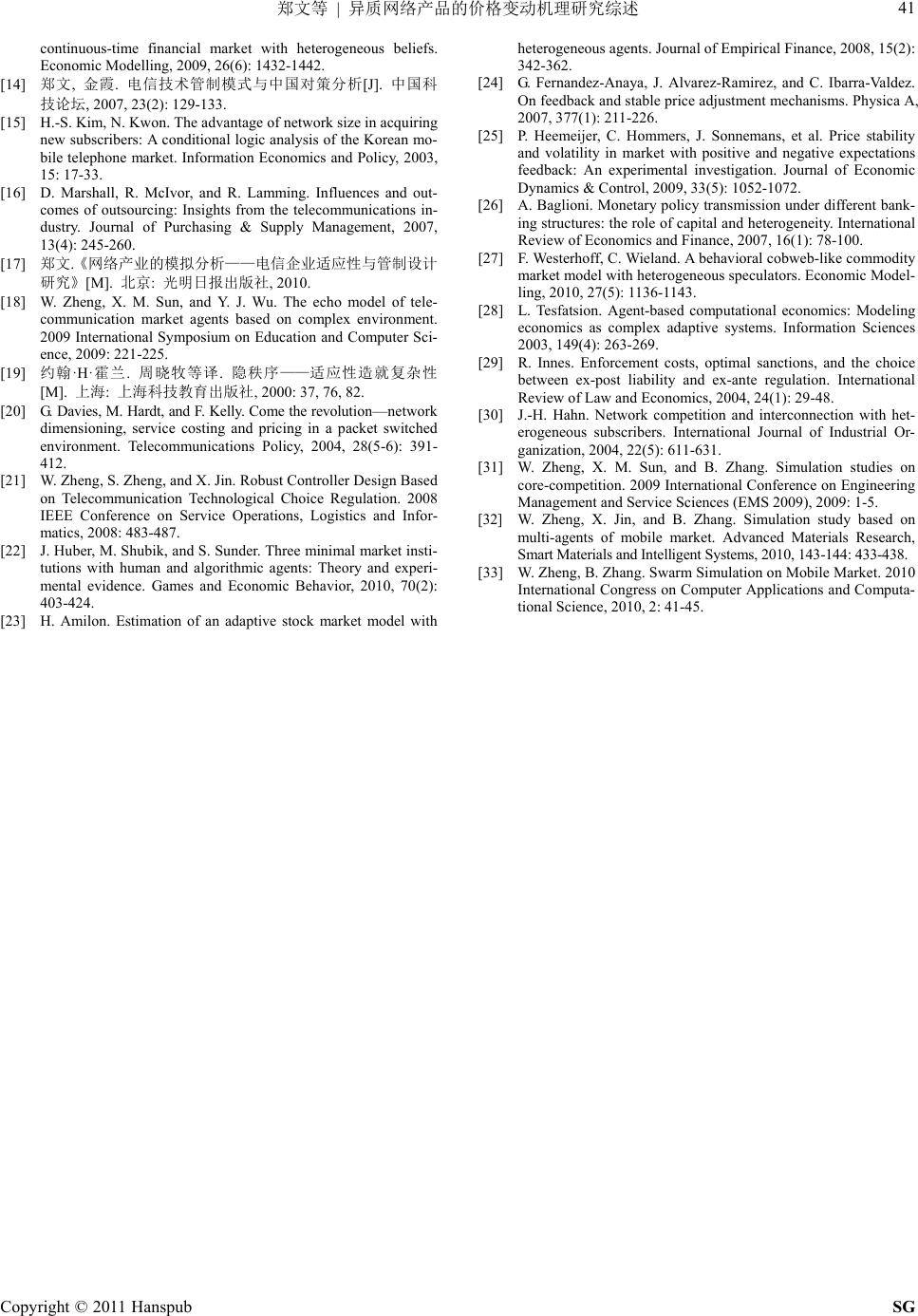 Smart Grid 智能电网, 2011, 1, 38-41 http://dx.doi.org/10.12677/sg.2011.11008 Published Online June 2011 (http://www.hanspub.org/journal/sg/) Copyright © 2011 Hanspub SG The Review on the Price Variation Mechanism of Heterogeneity-Network Products Wen Zheng1*, Shi Zheng2 1Management Department, Northeastern University at Qinhuangdao, Qinhuangdao 2School of Management, Dalian Minority University, Dalian Email: re s e archerzw@126.com Received: May 23rd, 2011; revised: Jun. 13th, 2011; accepted: Jun. 21st, 2011. Abstract: The research on the price and price variation mechanism of heterogeneity-network products is the implement of traditional price theory. It also gives a new explanation on possible impact elements of price variation. It has the practical value on improvement of the consumers’ welfare, the perfection of the market environment and the planning of the political conditions. Keywords: Market Environment; Heterogeneit y-Network Products; Price Variation; Price Variation Mechanism 异质网络产品的价格变动机理研究综述 郑 文1*,郑 时2 1东北大学秦皇岛分校管理系,秦皇岛 2大连民族学院经管分院,大连 Email: re s e archerzw@126.com 收稿日期:2011 年5月23日;修回日期:2011 年6月13 日;录用日期:2011 年6月21 日 摘 要:对于异质市场网络产品价格生成与变动机理的研究是对传统价格理论的完善,同时提供了新的 解释价格变动可能影响因素的思路,对于消费者福利的改进、市场环境的完善和政策条件的设计有实践 应用价值。 关键词:市场环境;异质网络产品;价格变动;价格变动机理 1. 引言 伴随网络经济的发展,是异质网络产品市场的繁 荣,与异质网络产品价格研究的深化[1-7]。价格一直是 市场经济的关键要素备受研究者的关注,成为理论研 究和市场实践的焦点。经济决策效率将更多的依赖于 有序市场条件,这在理论上已经获得了共识。在供应 链市场条件下,由于多智能参与主体的交互作用在多 个交互连接点中所形成的市场动态化特性,价格作为 市场动态化和复杂度的测量变量成为其中最难把握的 关键要素。如何在网络市场环境中将价格的变动特性 与变动范畴利用科学计量的方式得出定量化的结论 是经济、管理科学研究中的一个理论热点问题。 已有的研究表明[1-6],从复杂系统的角度分析价格 的形成原因与机理具有更强的现实意义和理论价值。 各类市场分析显示[5-7],价格是由更多因素所决定的非 线性复杂系统的产物,并成为系统的输入条件,进一 步影响系统的运行,价格变动是否还有其它特点,这 些动态又是如何形成的。对于异质网络产品这一类特 定的产品价格的生成与变动机制是如何形成的,需要 进一步探究。尤其是在当今信息化进程日益加快的背 景下,这一问题的成功解析将对网络产业的有效管制、 消费者福利的提升以及企业竞争力的提高起到正向的 作用。  郑文等 异质网络产品的价格变动机理研究综述39 | 2. 文献综述 2.1. 市场异质性分析 已有研究从交易策略、企业异质性和劳动力市场 偏好异质性分析市场异质性问题。Roberto Dieci, Xue-Zhong He et al.[1](2006) 研究了源于交易策略异质 性的市场动态分析。采用实证分析的方法,考虑不同 交易策略、复杂决策与决策者行为策略,构建“动态 市场分量”模型分析两类市场交易者,重要和跟随者, 一个市场构建者,按照固定和适应性变换分量的分类 法对两组市场参与者分别进行了动态的和渐进的系统 仿真。结果表明,价格的动态特征与市场参与者的适 应性信念、市场建构模式有着明确的相关关系。Marco Casari[2](2008)研究了由于企业的异质性形成的市场非 均衡状态,采用遗传算法,利用仿真模拟来分析在古 诺双寡头状态下,聚合式均衡市场的形成以及唯一对 称的纳什均衡解的实现,研究认为,企业的异质状态 不是市场中的决策随机变量,而是企业在市场中交互 作用过程中形成的认知局限。Marcelo Bianconi[3](2008 ) 从劳动力市场的偏好异质性,分析市场动态特征,研 究内生劳动力供给条件下的市场异质性特征和逆向选 择问题。研究结论认为,逆向选择源于劳动力市场的 内生选择。Hiroyuki Nishiyama et al.[4](2010) 从非对称 模型,分析企业异质性与外国直接投资的关系,进口 企业、国外直接投资企业、出口企业和本国企业在生 产能力上存在由高到低的能力差异。研究表明,国外 直接投资通过平均价格变动、国民收入和产品的类型 与数量来影响社会福利。 2.2. 异质性产品市场分析 对于异质性产品市场的相关作用,已有研究也进 行了分析。Johannes Binswanger[5](2010)从储蓄和资产 配置的异质性来分析生命周期模型。Kiyohiko G. Ni- shimura[6](1998)从异质化期望和价格敏感性的相关关 系,对比分析固定价格和变动价格对于商品市场和资 产市场的影响,利用非完美竞争和异质化期望的理论 框架分析和解释现象,引发异常的价格敏感度的因素 在商品市场和资本市场是不同的,在商品市场企业决 定数量和价格并决定供给、需求关系,卖者期望异质 性引发价格敏感。在资本市场,由于高交易成本,买 者期望异质性与价格敏感度增高存在正相关关系,研 究结果表明,市场一体化会加大价格敏感度。 2.3. 异质性产品的价格变动分析 对于异质性产品的价格变动范畴,以及变动特征 的研究,有研究者从主观偏好角度分析价格形成。Cars Hommes[7](2011)从实验验证异质性期望的理论假设, 采用学习–预测实验验证在考虑主观偏好的假设条件 下,预测市场价格变动范畴,在微观层面上考虑个体 期望,聚合为群体期望后,在宏观层面上涌现为群体 偏好。将异质性特征以微观聚合为宏观的方式通过实 验手段加以验证,并分析对于价格形成的影响作用。 2.4. 异质网络产品价格变动特征分析 已有研究从供应链市场中进行的分析。Chris- topher Kiekintveld et al.[8](2009)认为,经济决策将更多 的依赖于市场条件,在供应链市场条件下,多智能参 与主体的交互作用在多个交互连接点中所形成的市场 动态化特性,价格作为市场动态化和复杂度的测量计 是其中最为关键的要素。从价值链博弈的角度分析市 场价格预测问题,在未来不确定性和动态化的市场条 件下,价格将成为重要的决策制定要素。 2.5. 价格变动机理研究 对于价格变动机理的研究,有研究者从市场状态、 参与者策略和不同市场类型等方面进行分析。S. D. Flam et al.[9](2008)从市场出清和价格形成关系中分析 价格的均衡状态,对于随机函数在其中的影响作用进 行分析。基本假定在与经济行为是可以被试验的和可 以被验证的。Stelios D. Bekiros[10](2010)分析学习机制 在异质性交易策略中对于模糊适应性参与者的作用, 采用行为分析方法对于市场条件中的系统环境生成方 式和知识获取侧略、决策制定程序以及技术分析方式。 认为交易策略形成一类交易市场环境和交易者行为主 体的异质性策略,利用模糊影响规则来分析和评价适 应性结果。研究表明,模糊评价系统的学习机制设计 在评价效果上要优于神经网络模型和马尔科夫模型。 Carl Chiarella[11](2011)从金融市场对于异质市场参与 者进行分析,提出了异质代理人模型分析市场运作过 程中的决定要素及其作用。William Blyth[12](2009)从碳 Copyright © 2011 Hanspub SG  郑文等 异质网络产品的价格变动机理研究综述 40 | 市场分析政策作用及风险与价格形成的关系。 Xue-Zhong He[13](2009 ) 从异质信念分析金融市场稳定 性问题。 3. 研究假设 网络产业是目前世界上发展迅猛的产业之一。网 络市场、网络型企业与网络产品提供商在发展过程中 的作用各不相同[14-16],市场是网络产业发展的外在条 件因素,企业是网络产业发展的内在自组织主体[17,18]。 对网络型企业的自组织主体行为的研究有助于进一步 区分和细化网络市场特征[19,20],考察在管制者调控情 况下的市场运作模式[21]。在现实条件下,价格不仅是 供给和需求关系的产物,更是市场参与者博弈的结果, 是复杂适应系统生成的产物,同时价格与其他市场条 件一起作为系统的输入条件循环参与博弈过程,循环 的时间周期决定价格的变动周期、变动频率和变动阈 值。郑文[17]在《网络产业的模拟分析》一书中对网络 产品价格进行了 Swarm 仿真分析。 4. 研究方法 从研究方法来看,已有研究[1-2]对于实验手段分析 市场关键要素对于价格形成问题,也进行了深入的探 索。Juergen Huber et al.[22](2010)利用遗传算法和智能 主体实验研究分析市场的构成要素相关关系,与本研 究有着非常密切的联系。Henrik Amilon[23](2008)采用 的是智能主体的理论和实验分析方法,利用异质性代 理人分析适应性股票市场的价格波动机理。Guillermo Fernandez-Anaya et al.[24](2007)利用反馈控制理论,分 析稳定价格调整机理。Peter Heemeijer[25](20 09) 利用反 馈控制理论,参与实验分析方法,研究正向和反向的 反馈对于价格的稳定性和变动性影响,实验结果表明, 异质性输入条件影响价格的变动频率,市场的仿真效 果出现三种聚集状态。 政策对于异质性的影响作用,相关研究有 Angelo Baglioni和Frank Westerhoff的工作。Angelo Baglioni [26](2007) 在研究中分析了在不同银行业结构下,考虑 投资和异质性影响作用,货币政策的传导作用。Frank Westerhoff[27](2010)利用混沌理论的分叉分析,通过实 验分析验证,市场中出现蛛网产品市场模型的行为以 及政策对于调整市场稳定性和抑制市场泡沫出现的作 用。 5. 研究展望 国内外现有的研究表明,已有研究对于价格的变 动要素和价格的调整机制进行了研究[28-30]。方法上, 包括理论验证的方法和实验检验的方法,研究网络产 业在管制和非管制条件下价格的变动情况[28],并给出 了各变量间的相关分析[18,21,31-33] 。但更为细致的变动 因素以及变动机理没有从实验和实践的角度给出更为 深入的结论,有待进一步研究。 对于异质市场网络产品价格生成与变动机理的研 究是对传统价格理论的完善,同时提供了新的解释价 格变动可能影响因素的思路,对于消费者福利的改进、 市场环境的完善和政策条件的设计有着非常明显的实 践应用价值,同时也是理论研究的新视角与实验研究 方法的有机结合,这种实验研究方法为理论研究提供 可验证的方法。 参考文献 (References) [1] R. Dieci, I. Foroni, L. Gardini, et al. Market mood, adaptive beliefs and asset price dynamics. Chaos, Solitons and Fractals, 2006, 29(3): 520-534. [2] M. Casari. Markets in equilibrium with firms out of equilibrium: a simulation study. Journal of Economic Behavior & Organiza- tion, 2008, 65(2): 26 1-276. [3] M. Bi anconi. Heterogeneity, adverse selection and valuation with endogenous labor supply. International Review of Economics and Finance, 2008, 17(1): 1 1 3 -126. [4] H. Nishiyama. M. Yamaguchi. Foreign direct investment, inter- national trade, and firm heterogeneity. Economic Modelling, 2010, 27(1): 184-195. [5] J. Binswanger. Understanding the heterogeneity of savings and asset allocation: A behavioral-economics perspective. Journal of Economic Behavio r & Organization, 2010, 7 6 (2): 296-317. [6] K. G. Nishimura. Expectation heterogeneity and price sensitivity. European Economic Review, 1998, 42: 619-629. [7] C. Hommes. The heterogeneous expectations hypothesis: Some evidence from the lab. J o u rnal of Economic Dynamics & Control, 2011, 42(3-5): 1-24. [8] C. Kiekintveld, J. Miller, P. R. Jordan, et al. Wellman. Forecast- ing market prices in a supply chain game. Electronic Commerce Research and Appplications, 2009, 8(2): 63-77. [9] S. D. Flam, O. Godal. Market clearing and price formation. Journal of Economic Dynamics & Control, 2008, 32(3): 956-977. [10] S. D. Bekiros. Heterogeneous trading strategies with adaptive fuzzy Actor-Critic reinforcement learning: a behavioral approach. Journal of Economic Dynamics & Control, 2010, 34(6): 1153-1170. [11] C. Chiarella, X. Z. He, and M. Zheng. An analysis of the effect of noise in heterogeneous agent financial market model. Journal of Economic Dynamics & Control, 201 1, 35: 148-162. [12] W. Blyth, D. Bunn, J. Kettunen, et al. Policy interactions, risk and price formation in carbon markets. Energy Policy, 2009, 37(12): 5192-5207. [13] X. Z. He, K. Li, J. J. Wei, et al. Market stability switches in a Copyright © 2011 Hanspub SG  郑文等 | 异质网络产品的价格变动机理研究综述 Copyright © 2011 Hanspub SG 41 continuous-time financial market with heterogeneous beliefs. Economic Modellin g, 2009, 26(6): 1432-1442. [14] 郑文, 金霞. 电信技术管制模式与中国对策分析[J]. 中国科 技论坛, 2007, 23(2): 129-133. [15] H.-S. Kim, N. Kwon. The advantage of network size in acquiring new subscribers: A conditional logic analysis of the Korean mo- bile telephone market. Information Economics and Policy, 2003, 15: 17-33. [16] D. Marshall, R. McIvor, and R. Lamming. Influences and out- comes of outsourcing: Insights from the telecommunications in- dustry. Journal of Purchasing & Supply Management, 2007, 13(4): 245-260. [17] 郑文.《网络产业的模拟分析——电信企业适应性与管制设计 研究》[M]. 北京: 光明日报出版社, 2010. [18] W. Zheng, X. M. Sun, and Y. J. Wu. The echo model of tele- communication market agents based on complex environment. 2009 International Symposium on Education and Computer Sci- ence, 2009: 221-225. [19] 约翰·H·霍兰. 周晓牧等译. 隐秩序——适应性造就复杂性 [M]. 上海: 上海科技教育出版社, 2000: 37, 76, 82. [20] G. Davies, M. Hardt, and F. Kelly. Come the revolution—network dimensioning, service costing and pricing in a packet switched environment. Telecommunications Policy, 2004, 28(5-6): 391- 412. [21] W. Zheng, S. Zheng, and X. Jin. Robust Controller Design Based on Telecommunication Technological Choice Regulation. 2008 IEEE Conference on Service Operations, Logistics and Infor- matics, 2008: 483-487. [22] J. Huber, M. Shubik, and S. Sunder. Three minimal market insti- tutions with human and algorithmic agents: Theory and experi- mental evidence. Games and Economic Behavior, 2010, 70(2): 403-424. [23] H. Amilon. Estimation of an adaptive stock market model with heterogeneous agents. Journal of Empirical Finance, 2008, 15(2): 342-362. [24] G. Fernandez-Anaya, J. Alvarez-Ramirez, and C. Ibarra-Valdez. On feedback and stable price adjustment mechanisms. Physica A, 2007, 377(1): 211-226. [25] P. Heemeijer, C. Hommers, J. Sonnemans, et al. Price stability and volatility in market with positive and negative expectations feedback: An experimental investigation. Journal of Economic Dynamics & Control, 2009, 33(5): 1052-1072. [26] A. Baglioni. Monetary policy transmission under different bank- ing structures: the role of capital and heterogeneity. International Review of Economics and Finance, 2007, 16(1): 78-100. [27] F. Westerhoff, C. Wieland. A behavioral cobweb-like commodity market model with heterogeneous speculators. Economic Model- ling, 2010, 27(5): 1136-1143. [28] L. Tesfatsion. Agent-based computational economics: Modeling economics as complex adaptive systems. Information Sciences 2003, 149(4): 263-269. [29] R. Innes. Enforcement costs, optimal sanctions, and the choice between ex-post liability and ex-ante regulation. International Review of Law and Economics, 2004, 24(1): 29-48. [30] J.-H. Hahn. Network competition and interconnection with het- erogeneous subscribers. International Journal of Industrial Or- ganization, 2004, 22(5): 611-631. [31] W. Zheng, X. M. Sun, and B. Zhang. Simulation studies on core-competition. 2009 International Conference on Engineering Management and Service Sciences (EMS 200 9), 2009: 1-5. [32] W. Zheng, X. Jin, and B. Zhang. Simulation study based on multi-agents of mobile market. Advanced Materials Research, Smart Materials and Intelligent Systems, 2010, 143-144: 433-438. [33] W. Zheng, B. Zhang. Swarm Simulation on Mobile Market. 2010 International Congress on Computer Applications and Computa- tional Science, 2010, 2: 41-45. |